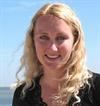The top of the world
It was a dark and stormy night… No, actually it was a bright and sunny night when we arrived at Longyearbyen airport at 1:30am. With the midnight sun greeting us among the snow-capped mountains and rippling waters of the Adventfjorden, it felt like a totally different world – and that’s exactly what it is compared with the Netherlands!
Although there is very little vegetation, and nothing above ankle height, the rugged natural beauty of the fjords and glacier-scoured hillsides are simple breath-taking. The town of Longyearbyen is an old mining town, now mainly converted into a tourist base camp for the various outdoorsy, adrenaline seeking adventurers and cruise ship passengers. The town is nestled in a valley overlooked by two majestic glaciers (Longyearbreen and Larsbreen) visible at the top of the main road. The shops lining the main road are all outdoor shops selling ultra-warm clothing and gear appropriate for the polar climate, the rest are restaurants, hotels, and a supermarket.

The main street of Longyearbyen (photo by Anneke van den Brink)
After a ‘night’ to recover from travelling, we got started with preparations for our expedition. Our first stop was at UNIS (University Centre in Svalbard), the world’s northernmost higher education institution, and a field station used by various Norwegian and foreign research institutes. We were there to collect and sort through our sampling materials and other field gear. UNIS has a friendly atmosphere where everyone shares a similar mind set of researching and protecting this amazing place, and all the people we spoke to were very interested in our project.
Once our materials were sorted, Martine and Hans went to a safety training refresher course while Rebecca and I continued to prepare some last bits and pieces. Once that was complete, we all set off to the supermarket to stock up on food supplies for the coming week, because there won’t be any shops where we are going!

Sorting out the gear in the hallway at UNIS (photo by Hans Verdaat)
We finished the evening exploring beyond Longyearbyen on the only road that there is to follow. We were treated to sightings of pink-footed geese, barnacle geese, red-throated divers, a reindeer and an arctic fox which appeared very happy to have found a carcass to feast on. We passed the husky kennels, the NASA satellite station, right to the end of the road at the top of the hill where we were rewarded with stunning views of the fjord, the glaciers and valley below.

Over the mountains near Longyearbyen (photo by Martine van den Heuvel-Greve)
All the gear is now ready to be loaded onto the boat which will be our home for the next seven nights. The remote coasts of Svalbard await us, and our mission is to see whether or not we the only newcomers to the beaches.

Preparing the formalin to preserve the samples (photo by Anneke van den Brink)

Down the valley towards Longyearbyen (photo by Hans Verdaat)
More about this project: https://www.wur.nl/en/project/Aliens-on-the-beach.htm

